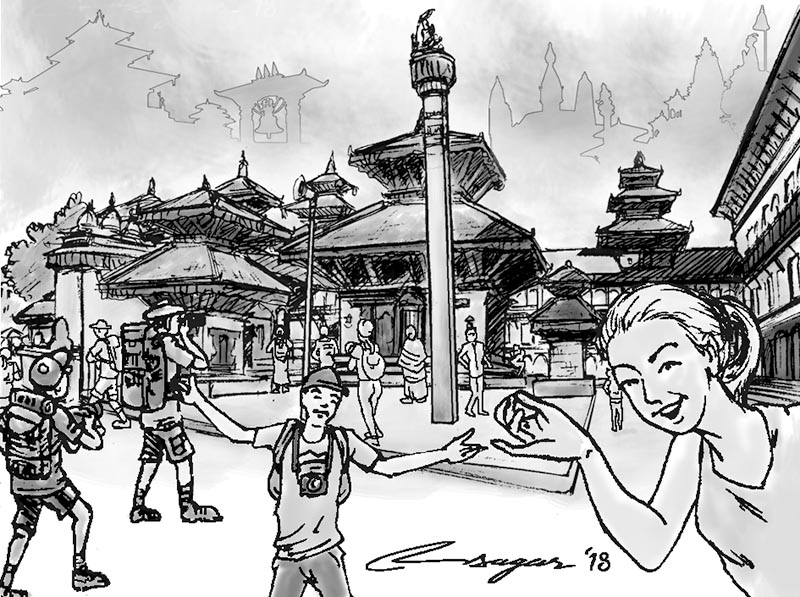Branding the city: A way to promote tourism
Nepal’s rich architectural heritage is a major attraction for people from around the world. The remarkable architecture of Nepal can be used as a branding tool to establish it as one of the major tourist destinations in the world
"Architecture” is a term so common and yet so vague. While at the most basic level, architecture is the art and practice of designing and constructing buildings, it is also the physical manifestation of the social, cultural and political environments which produced it. It is an expression of lifestyle and spirit of the times in which it aroused. How buildings are designs says so much about who lived during that time and what they valued. It is so fascinating how architecture can keep the spirit of a lost era alive and intact.
Architecture and tourism are very closely related activities. They can be said to depend on each other. Their mutual relationship is obvious since ancient times where the architecture, as a tourist attraction, had a very important role.
In fact architecture has always triggered tourism by its values as either being witnesses to historical events or merely by their originality. Architecture in terms of tourism is an integral element of the planning of the city, whether it is of cultural heritage or contemporary architecture. When it comes to heritage, it is the architecture resulting in a particular context that is completely defined and therefore is a testimony about history. In this sense, the architecture can become a brand that describes the identity of a certain place.
People travel for various reasons but what excites many of them the most is seeing the architecture and experiencing the culture. This is because architecture is a strong means of expression that affects the spectators emotionally. Uncountable stories can be unfolded through architecture. Walking into a space, people can be engulfed in the symbolism, care and intention that went into its design. Therefore architecture is a very powerful marketing tool in the tourism sector.
Since architecture helps in creating an image that sums up the real essence of a city/place, the travel itinerary of most of the tourists is greatly influenced by the architecture of the place they are travelling to. For instance, the must see places in the itinerary of a tourist visiting Kathmandu will definitely encompass heritage, culture and architecture which includes the three historic Durbar Squares, Swayambhunath Stupa and Boudhanath Stupa.
From the temples and palaces in Durbar Squares to the small alcoves holding devotional statues nested on the busy streets all over Kathmandu, Nepal’s unique architectural and cultural heritage is recognised worldwide which makes Nepal a popular travel destination. Most tourists visit Nepal to experience its diverse mix of religions, ethnic groups and cultures reflected through architecture. They come here to witness the wonders of Nepali craftsmanship. And since most tourists are attracted towards our rich culture, traditions, historic sites, monuments, etc, tourism can be considered a governing factor in the conservation of the mentioned.
Nepal’s history has always been the main asset of its global image. Besides maintaining and preserving the assets of our country, it is also equally important to promote them in the global market. Simply put, this means “Adding values to assets.” And this can be achieved through “City branding”.
“City branding” is a very complex process. It is an art of creating an image of a city in people’s mind so that they are attracted towards it. Moreover, it is about turning a city/country from a “location” to a “destination”. Good branding can make a city desirable. Elements of brand identity include culture, slogans, visual symbols, values, etc.
City branding tends to revolve around the elements that identify the unique character of the city. In our case, what makes Nepal stand out is its rich architectural heritage. The remarkable architecture of Nepal can be used as a branding tool to establish it as one of the major tourist destinations in the world.
Some examples of well branded places are New York City, San Francisco, Paris, Rome and Melbourne among others. These successful city brands marketed their history, quality of place, lifestyle, culture and diversity. New York City is easily one of world’s largest branded cities. The slogan “I LOVE NYC” promotes the idea that NYC is a place people would like to visit, live in and become a part of. This clever, yet simple concept has been used since 1977 to promote tourism in NYC.
Similarly, Amsterdam is another city that had a positive outcome from place branding. “I AMSTERDAM” is both a motto and a trademark which was introduced in 2004 to rebrand the city as a growing hub for tourists and businesses. Other places have also come up with taglines aimed to boost tourist arrivals. For example within the “Incredible India”, there are “Jaipur — the Pink City”, “Jodhpur — the Blue City”, “Jaisalmer — the Golden City”, etc. These cities got their taglines based on their unique architecture thus giving them a distinct identity in the global stage.
Nepal is also not behind and the government is doing its bit to promote the country. The Nepal Tourism Board has introduced a campaign called “Visit Nepal 2020”, aiming to attract two million foreign tourists to the country. Similar approach and marketing strategy can be formulated to turn Nepal into an attractive tourist destination. For this it is very essential to articulate what the city/country has best in it and how it is different from other competitors.






